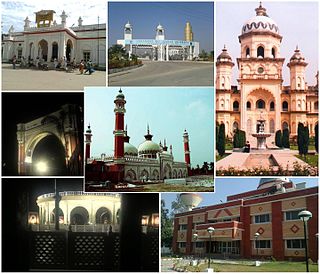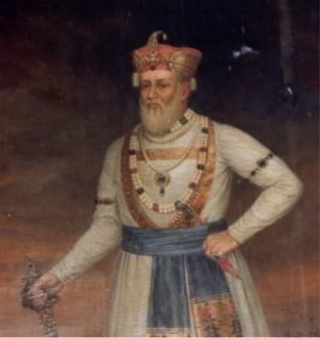Related Research Articles

Rampur is a city, and the municipality headquarter of Rampur District in the Indian state of Uttar Pradesh. It was formerly known for its various industries, like sugar refining and cotton milling. Its library has more than 12,000 rare manuscripts and a fine collection of Mughal miniature paintings. It is located 322 kilometres north-west of the state capital Lucknow.

Rohillas are an Indian community of Pashtun ancestry, historically found in Rohilkhand, a region in the state of Uttar Pradesh, India. It forms the largest Pashtun diaspora community in India, and has given its name to the Rohilkhand region. The Rohilla military chiefs settled in this region of northern India in the 1720s, the first of whom was Daud Khan.

The Bareilly districtpronunciation (help·info) belongs to the state Uttar Pradesh in northern India. Its capital is Bareilly city and it is divided in six administrative division or tehsils: Aonla, Baheri, Bareilly city, Faridpur, Mirganj, and Nawabganj. The Bareilly district is a part of the Bareilly Division and occupies an area of 4120 km2 with a population of 4,448,359 people according to the census of 2011.

Bijnor district is one of the 75 districts in the state of Uttar Pradesh in India. Bijnor city is the district headquarters. The government of Uttar Pradesh seeks it to be included in National Capital Region (NCR) due to its close proximity to NCT of Delhi.

Bijnor is a town and a municipal board in Bijnor district in the state of Uttar Pradesh, India
Ali Muhammad Khan was a Rohilla chief who founded the Kingdom of Rohilkhand in the northwestern region of the Uttar Pradesh state of India. He succeeded his foster father Sardar Daud Khan Rohilla at the age of fourteen and was generally regarded as a non-oppressive ruler to the masses. He was well regarded for his political ability, and was granted the right to use India's highest insignia of the Mahseer by the Emperor Muhammad Shah. His young death along with the tender age of his children led to Hafiz Rehmat Khan's regency which was in large part governed against his wishes, despite Rehmat Khan's solemn oath on the Quran to fulfil dying Ali Mohammad's will.

Najib ad-Dawlah, also known as Najib Khan Yousafzai, was a Rohilla Yousafzai Afghan who earlier served as a Mughal serviceman but later deserted the cause of the Mughals and joined Ahmed Shah Abdali in 1757 in his attack on Delhi. He was also a House chief of Rohilkhand, and in the 1740s founded the city of Najibabad in Bijnor district, India. He was instrumental in winning the Third Battle of Panipat.

The First Rohilla War of 1773–1774 was a punitive campaign by Shuja-ud-Daula, Nawab of Awadh on the behalf of Mughal Emperor, against the Rohillas, Afghan highlanders settled in Rohilkhand, northern India. The Nawab was supported by troops of the British East India Company, in a successful campaign brought about by the Rohillas reneging on a debt to the Nawab.

Hafiz Rahmat Khan was the Regent of Rohilkhand in North India, from 1749 to 1774. He was a Pashtun by background, ruling over Rohillas. Hafiz Rahmat Khan had served honorably throughout the reign of three Mughal Emperors: Ahmad Shah Bahadur, Alamgir II and Shah Alam II. He was also a mentor of Prince Mirza Jawan Bakht.

Nawab Faizullah Ali Khan was the first Nawab of Rampur. The princely state of Rampur was set up in year 1774, after the First Rohilla War, by the dismemberment of the Rohilla Kingdom of Rohilkhand. Faizullah Khan, the only surviving heir of Ali Mohammed Khan and opponent of the forces of Awadh and the British East India Company in the war, was installed as ruler of what was the newly created Rampur State. It bordered the Maratha Empire to the south, making it a strategic point. Under tutelage of the East India Company, Faizullah Khan ruled peacefully for 20 years. The capital Rampur was founded, and the Raza Library collection gathered.

Rampur State was a 15 gun-salute princely state of British India. It came into existence on 7 October 1774 as a result of a treaty with Oudh. Following independence in 1947, Rampur State and other princely states of the area, such as Benares and Tehri Garhwal were merged into the United Provinces. Rampur state had its capital in Rampur city and its total area was 945 sq miles. Rampur state was founded by Ali Mohammad Khan's younger son Faiz-ullah Khan.
Jat Muslim or Musalman Jat, also spelled Jatt or Jutt, are an ethnoreligious group and a sub-group of the Jat people, who are followers of Islam and are native to the northern regions of the Indian Subcontinent. They are found primarily throughout Sindh and Punjab regions of Pakistan, with a small population in Afghanistan. Jats began converting to Islam from the early Middle Ages onward, and constitute a distinct sub-group within the diverse community of Jat people.

Al-Haj Nawab Ghulam Muhammad Khan Bahadur was briefly Nawab of Rampur from 1793 to 1794. The younger son of Faizullah Khan, Ghulam Muhammad became Nawab in 1793 after deposing his elder brother, Muhammad Ali Khan Bahadur. His reign quickly took on a tyrannical aspect, and he was soon deemed a danger to the region's stability. Thus, in 1794, he was himself deposed by troops of the East India Company and of the Nawab of Awadh, being succeeded as Nawab by his nephew, Ahmad Ali Khan Bahadur. Ghulam Muhammad then undertook the Hajj, after which he fled to Mysore and Tipu Sultan, later settling in the Punjab. He died at Nadaun in 1828.
Ali Khan may refer to:

The Second Rohilla War was a conflict between British India and the Rohillas of Rampur in 1794. John Shore was the Governor-general at the time of war.

Nawab Abdullah Khan Bahadur Rohilla was the eldest son of Nawab Ali Muhammad Khan of Rohilkhand and succeeded in absentia to the throne of Rohilkhand and Budaun. He was deposed by the machinations of Hafiz Rehmat Khan and replaced with his younger brother, Nawab Saadullah. Afterwards, he retreated to a spiritual life of an ascetic. He eventually died fighting the British in the Rohilla War.

Nawab Abdullah Khan Bahadur Rohilla was the third son of Nawab Ali Muhammad Khan of Rohilkhand and succeed his brother to the throne of Rohilkhand.

The Kingdom of Rohilkhand was a Indo-Muslim state, nominally under Mughal suzerainty, that arose under the declining Mughal Empire in 1721 and continued to exist until 1774 when annexation by the British transformed its significantly reduced borders into the Princely State of Rampur. Nawab Ali Mohammed Khan became the first Nawab of Rohilkhand, having been previously elected as overlord by various Afghan Chiefs at the age of fourteen. He would carve out the future kingdom from the collapsing Mughal Empire and go on to the found the Rohilla dynasty. The crown would go on being held by the Rohillas until the kingdom came to an end in 1774, and thereafter the same dynasty would rule over Rampur.

The Rohilla dynasty was a dynasty that ruled over much of North-West Uttar Pradesh in the form of Rohilkhand and later until 1947, the Princely State of Rampur. At the height of their power the dynasty ruled over the Kingdom of Rohilkhand and held suzairnty over the Kingdom of Kumaon and Kingdom of Garhwhal.
References
- ↑ Penny Magazine of the Society for the Diffusion of Useful Knowledge, Volume 12 page 429